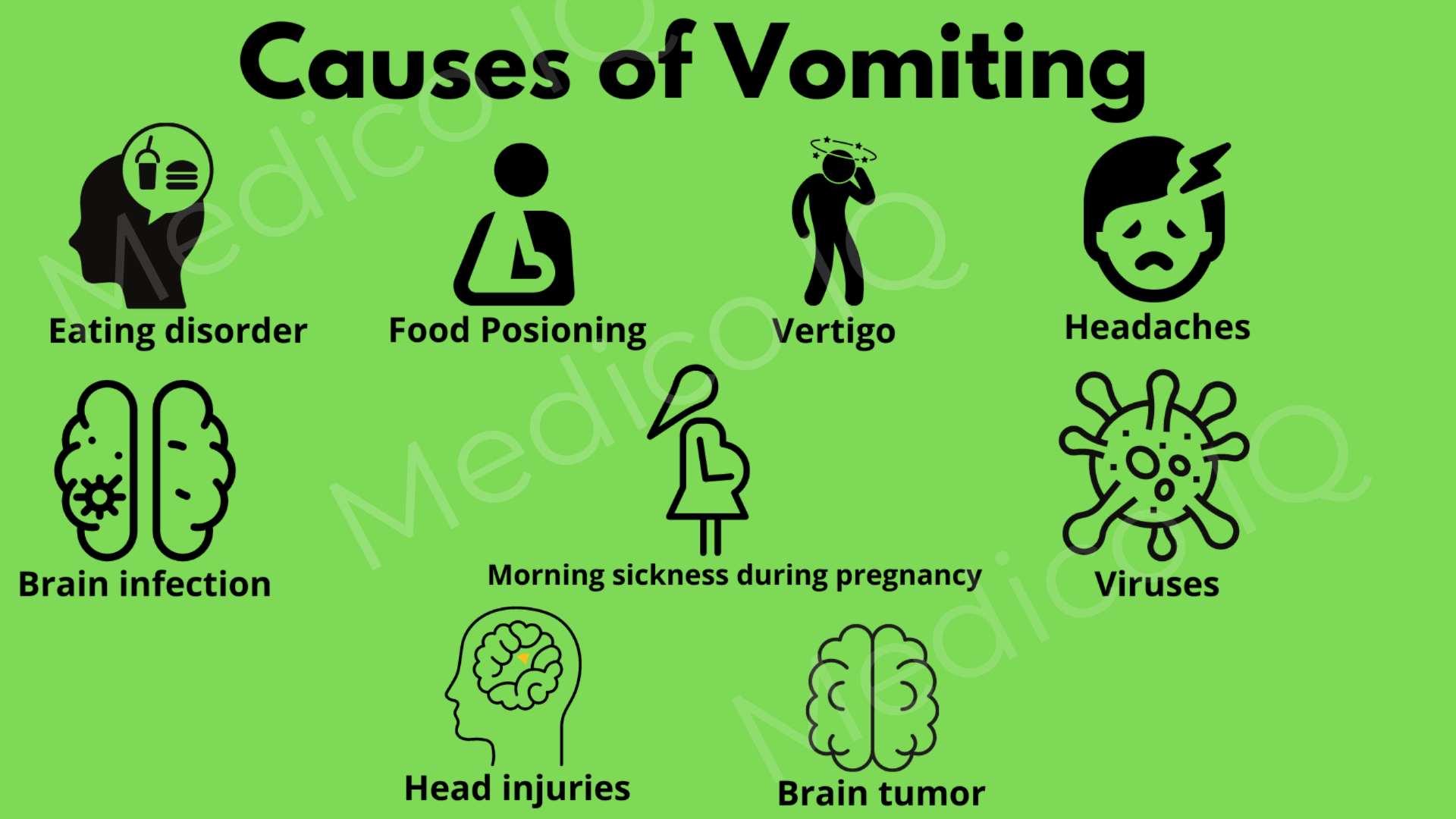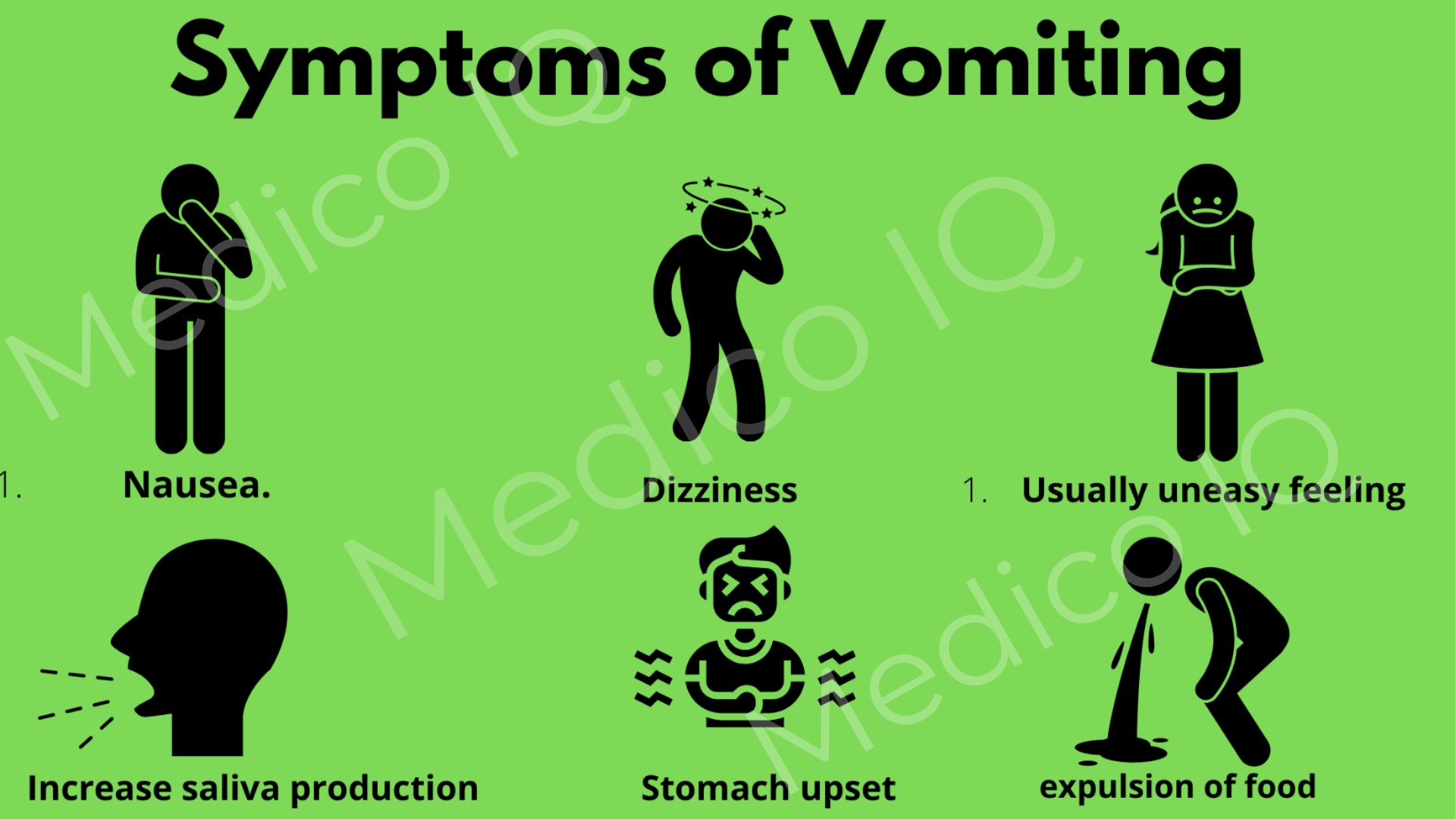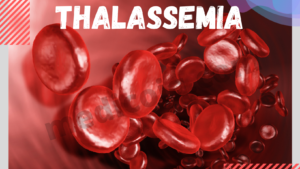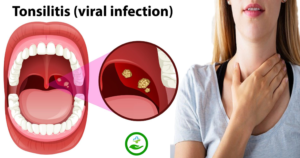Table of Contents
What Is Vomiting
Vomiting is forcing the contents of the stomach up throughout the mouth. To remove the non-toxic or harmless substance from the body after ingestion is called emesis.
Vomiting is a violent act in which the empty stomach has to overcome the pressure that in place to keep solid food and secretion within the stomach.
The empty stomach almost reflexes itself inside out –forcing into the lower portion of the esophagus during emesis episodes.
Vomiting is a cause is food poisoning and gastritis head injury, brain cancer. Nausea and vomiting is the discomfort felt before emesis but not all worsen nausea results in emesis.
Vomiting Accomplished By
Emesis is accomplished by a fierce, downward contraction of the diaphragm muscles.
At the same time, the abdomen muscles tighten against a relaxed stomach with an open gastro-esophageal sphincter.
The content of the stomach is propelled up and out.
Vomiting Reflex
As a part of the body reflex person may produce excessive saliva just before the emesis.
It is a complex, coordinated reflex orchestrated by the emesis center of the brain. that response to brain signals coming from;-
- The mouth, stomach, and intestine.
- The bloodstream, which may contain medicine or infections.
- The balancing system in the ear (morning sickness).
- The brain itself, including unsettling sights, smells or thought.
Definition Of What Is Vomiting
Nausea and the desire to do nothing Sometimes, the symptoms are referred to as sick. Food pipes (the esophagus) are forced to carry poop and vomit into the mouth.
Types of Vomiting
Depending on the causes of the vomiting, there can be different types. The different types of emetics are seen in the nature of the ejected material i.e. vomitus.
The simple kind of emesis is that which occurs when a person overeats.
Vomitus contains a fragment of undigested food , bland foods that is expelled out of the digestive tract due to the overloading in the stomach and upset stomach.
Such as vomit is not harmful. In fact, it is beneficial because it frees up the overstuffed alimentary tract.
In people with the chronic problem as gastritis, gastric ulcer, esophageal or gastrovaricos and digestive tract hemorrhage the person may vomiting blood.
Such as condition is known as hematemesis. It is a dangerous condition and required medical treatment.
Few times they contain browny particles that look like a coffee bean. Actually, it’s a semi-solid particle of blood that is oxidized of iron. which has already oxidized.
That is called coffee grounds vomiting, which is a symptom of several airborne infectious diseases.
Causes Of What Is Vomiting
Commonly emesis reflex trigger by brain signals, and this signal can be generated by smell, taste, various types of illness, and emotions like severe pain, motions, injury, fear, food irritation, infection, dizziness and etc. Specifically these
- Eating disorder (anorexia and bulimia )
- Certain viruses.
- Food poisoning and food allergies.
- Infection, viruses.
- Motion sickness.
- Vertigo ( the sensation that the room is spinning around ).
- Head injuries.
- Severe include Headache.
- Migraine headaches.
- Brain tumor.
- Brain infection (meningitis ).
- Morning sickness during pregnancy.
- Chemotherapy in cancer patients.
- Hydrocephalus ( Too much fluid in the brain).

Causes Of Vomiting
Infant Vomiting (0-6 months baby)
- Food Allergy.
- Milk Intolerance.
- Gastroenteritis.
- Gastroesophageal reflux.
- Congenital pyloric Stenosis.
- The air-born error of metabolism.
- intestinal obstruction.
- infection Often accompanied by fever or runny nose.
- Drugs poisoning.
Check it the causes,treatment,symptoms and other details of Hypertension.
Pathophysiology Of Vomiting
Vomiting is so many sources of having to vomit center:
- The chemoreceptor trigger is the base of the fourth ventricle has numerous dopamine D2 receptors,serotonin5-HT receptors, opioid receptors, acetylcholine receptors, and receptors for substance p.stimulation of the different receptor are involved in the different pathway leading to emesis, in the final common pathway substance appears involved.
- The vestibular system, which sends information to the brain via control nerve-VIII (Vestibulocochlear nerve), plays a major role in motion sickness and is rich in muscarinic receptor and histamine H1 receptors.
- The cranial nerve X(vagus nerve) is activated when the pharynx is irritated, leading to a gag reflex.
- The vagal and enteric nervous system inputs transmit information regarding the state of the gastrointestinal system irritation of the GI mucosa by chemotherapy, radiation, distention, or acute infections gastroenteritis activates the 5HT receptors of these inputs.
- The CNS mediates vomiting that arises from psychiatric digestive disorders and stress from higher brain centers.
The vomiting act encompasses three types of output initiated by the chemoreceptors trigger zone, motor parasympathetic nervous system, and sympathetic nervous system the are follows
- Increased salivation to protect tooth enamel from stomach acids .exessive emesis leads to dental erosions .this is part of PNS.
- The body takes a deep breath to avoid aspirating vomit.
- Retroperistalsis starts from the middle of the small intestine and sweeps up digestive tract contents into the stomach, through the relaxed pyloric sphincter.
- Intracranial pressure lower (by inspiration against a closed glottis) coupled with an increase in abdominal pressure as the abdominal muscles contract, propels stomach contents into the esophagus as the lower esophageal sphincter relaxes.
- The stomach itself does not contract in the process of vomiting except for at the angular notch nor is there any retroperistalsis in the esophagus.
- It is ordinarily preceded by retching
- Emesis also initiates an SNS response causing both sweating and increase heart rate.
- The neurotransmitter that regular vomiting are poorly understood but inhibitors of dopamine, histamine,e, and serotonin are all used to suppress Emesis, suggesting that these play a role in the initiation or maintenance of a vomiting cycle. vasopressin and neurokinin may also participate.
Symptoms Of What Is Vomiting
Following are some of the most common reason produce symptoms of vomiting
- Increase saliva production in some cases.
- Involuntary expulsion of food from the mouth and nose.
- Usually uneasy feeling
- Nausea.
- Stomach upset.
- Dizziness and Anxiety are also very common symptoms that precede emesis.
- Severe Abdominal pain.

Symptoms Of Vomiting
Mechanism Of vomiting
Vomiting is usually three phases of reflex mechanism, which everyone reading this has to experience. Nausea, Retching, or emesis.
Nause
Gagging, retching, choking, involuntary abdominal movements, a saliva-filled mouth, and bending over to avoid gastrointestinal issues are all signs include of vomiting.
Retching
The second stage is called dry heaves or reaching. There is a follow nausea and vomiting. Without any expulsion of gastric content can occurs without any vomiting but usually generating the negative pressure that leads to emesis.
Vomiting
The final stage is vomiting occurs when the gastric and often small intestine content is propelled up to and out of the mouth. It results from a highly coordinated serious event that could be described as the following series of steps;-
A deep breath is taken the glottis is closed and the larynx is raised to open the upper esophageal sphincter.
Also, the soft palate is elevated to close off the posterior nares. The diaphragm is contracted downward and opening of the gastric cardiac.
Treatment And Medication Options For Vomiting
Medical treatments for vomiting usually involves medicine to decrease vomiting nausea and fluid replacement for dehydration , By drug therapy
Pharmacologic
Centrally Anti-Emetics-
- Dopamine D2receptor Antagonist-: Haloperidol.
- Sedative Hypnotics-: Barbiturates (pentobarbital), Benzodiazepines (Diazepam).
Central and Peripheral Anti-Emetics-
- Anticholinergics-: Atropine, Hyoscine, Dicyclomine.
- Antihistamines (H1 Antagonist )-: Cyclizine, Meclizine, Promethazine, and Diphenhydramine, Doxylamine, cinnarizine.
- 5-HT3 Receptor Antagonist-: Ondansetron, Granisetron,Palonosteron,Ramosetron.
- Neuroleptics (D2 Blockers) (Tranquilizers)-: Domperidone, Phenothiazines, Chlorpromazine, Prochlorperazine, Haloperidol, Triflupromazine.
- Accelerators of gastric emptying-: Metoclopramide, Domperidone, Cisapride, Mosapride, Itopride.
- NK1(Neurokinin) Receptors antagonists -Aprepitant,Fosaprepitant.
Peripheral Anti- Emetics;
- Demulcents-: Gum Acacia, Gum Tragacanths.
- Adsorbent and Astringent-: Aluminium Hydroxide, kaolin, Bismuth Carbonate.
- Gastric Mucosal Anesthetics-: Chlorobutane, Oxethazaine.
Drug Acting By Removing Spasm-
- Relieving Myogenic Spasm-: Volatile oils, spirits, camphor menthol.
- Relieving Neurogenic Spasm-: Atropine, Hyoscine, propantheline.
Non-Pharmacologic
The nonpharmacologic method is used to vomiting treated by following types
- Acupressure
- Hypnosis
- Acupuncture
- Muscles relaxation Technique
- Distraction
- Behaviour Therapy
- guided Imagery.
Home Remedies of Vomiting
- Drinking a small number of sweet fruit juices during nausea and vomiting can prevent vomiting.
- Taking a mixture of one teaspoon of mint juice, half teaspoon of ginger juice, one teaspoon lime juice, and one teaspoon of honey it relief of comes to emesis.
- One and one-half cup of water to the mixture in boil half cup of rice to filter and drink the residual water acts as an effective and cure vomiting.
- Smelling an orange peel help stop emesis.
- Taking one teaspoon of onion juice at a regular interval reduces emesis.
- Taking a mixture of honey and cardamoms. Eating this mixture twice and thrice a day to stop the vomiting problems.
- Ginger tea is also very effective in vomiting. but this tea is made without sugar.
- Also Taking the mixture of apple cider vinegar and honey, but it takes before going to sleep .and their most important thing is that its very effective in cure those who have to suffer a daily emesis problem.
- Half a teaspoon of grounded cumin seeds taken in water prevents vomiting.
- Use clove after feeling emesis. keeping clove on the mouth and let it slowly spread its aroma.
Diet For Vomiting
- During the Vomiting period, your body loses water and other body fluid, in that case, your body wants more water so you should drink water in moderate quantities from time to time, it balances your body fluid.
- Add Steamed vegetables and vegetable soups to your diet. It helps your healthy digestion.
- Apple juice, bilberry juice, and other similar sweet juice should be taken.
- Rice, oats, bananas also help to solve Vomiting.
- During vomiting avoid some foods and drinks like coffee, alcoholic beverages, strong spice foods, milk, and milk products for some days.

Complications of Vomiting
The loss of fluids in the bloodstream, which causes the intestines to become dehydrated, is the primary cause of vomiting.
A person can’t do what it does normally if they don’t drink enough water. Conditions that cause dehydration can happen to anyone, but it’s especially dangerous when a young child can’t see adult symptoms.
Because they are less hydrated, older adults may also experience more severe dehydration occur
. Older adults may experience health issues or take medications that can dehydrate them.
How is Vomiting Diagnosed?
When vomiting is suspected, it’s important to get some medical tests done to figure out what’s going on.
It is possible that you are experiencing edema if you have taken a medicine that causes diarrhea. The patient will have their blood tested to see if they have an infection.
An ultrasound can also help the woman get pregnant. Additionally, the doctor is able to observe signs of dehydration, such as swollen lips, dark urine, dizziness, fatigue, and the need to sweat and urinate.
Related Conditions To Vomiting
People who have experienced vomiting aren’t usually dangerous and usually pass away quickly, but certain conditions are linked to severe and frequent vomiting.
Morning sickness is referred to as hyperemesis gravidarum. A disorder related to pregnancy affects about 3%.
It may result in weight gain depending on how emaciation or treat dehydration .
Another uncommon condition that causes severe nausea and vomiting is called ciclic vomiting syndrome.
Is Vomiting Harmful?
Vomiting can frequently result in serious illness.
Meningitis and concussion are two serious illnesses that can cause nausea and vomiting; Appendicitis, intestine blockages, and brain tumors are some of the symptoms.
The lack of water is a major concern. Adults are more likely to recognize signs like thirsty lips and a mouth rash, so they are less likely to become dehydrated.
Additionally, children who have diarrhea are more likely to become dehydrated.
Prevention of Vomiting
During nausea and vomiting people experience vomiting.
Symptoms include vomiting in your stomach, ache in your mouth – a mouth filled with saliva – to prevent teeth from stomach acid – and the need for movement.
During a period where nausea is felt, it is important for therapists to rest in the reclined position.
Pregnant women who have morning sickness should eat crackers before getting into bed. Sixty-seven.
Causes And Risk Factors Of Vomiting
The belly’s involuntary response is to vomit. Eating too much can occasionally also cause vomiting. The Maya clinic says there are many different symptoms of nausea.
FAQs
What is vomiting explain?
A disgusting reflex that involves exhaling stomach contents through the mouth is vomiting. The word “sickness” is one of those. include nausea does not imply vomiting; rather, it is a sensation of vomiting.
What causes vomiting in?
Nausea and vomiting are not diseases; rather, they are symptoms of a variety of illnesses, such as infections (the “stomach flu”), food poisoning, motion sickness severe pain, overeating, and infections that block the stomach.
What does vomiting feel like?
Gagging, retching, choking, involuntary abdominal movements, a saliva-filled mouth, and bending over to avoid gastrointestinal issues are all signs of vomiting.







